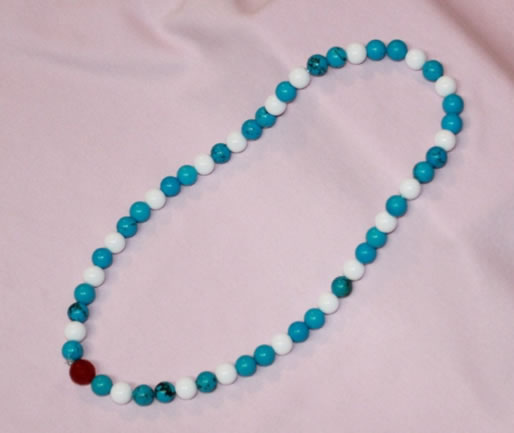Golden Ratio Necklace

This necklace is a linear model of the "Quasi Crystal", the discoverer of which received this year's Nobel Award in Chemistry. This model is a ringed arrangement of the Fibonacci sequence. Instead of the original demonstration of this sequence by Fibonacci (in1202) for which Fibonacci used female and male rabbits, in this necklace model blue and white beads are used...
The beads are strung according to the following pattern:
1. Begin the arrangement with three beads, blue, white and blue. These colors are denoted by the letters as BWB.
2. To generate the next generation of the sequence, follow the rule, B→BW, W→B.
For example the above initial sequence changes into the next sequence of BWBBW.
3. The third sequence develops as BWBBWBWB and so on and on.
If you count the total numbers of B plus W and also the each sum of B and W, in above example, you find a same sequence of numbers 3, 5, 8. The Fibonacci sequence in mathematics is given as (0,1,1,2,3,5,8,13,21,34, 55,89...). Notice the fact that the addition of successive two numbers produces the next number.
The above necklace is made simply by connecting 21 white beads and 34 blue beads (total 55 beads) arranged according to the rules explained above. Only 53 beads are seen in the necklace because one white and one blue bead are represented by one large red bead. The purpose of doing so is to make it look more colorful and also to make the necklace symmetrical.
The crux of the appeal of this necklace exists in the ratio of the numbers of B and W beads. This ratio in the above ring is 34/21 = 1.6190. As the total number of the beads increases the ratio approaches infinitely close to the so called "golden ratio" (= 1.61803398...) which is known as the most beautifully balanced ratio or proportion frequently used in architecture and in other objects. The golden ratio is an irrational number hence the balance of the numbers of B and W in the above necklace may give you a little bit of irrational feeling so that it may always create new stimulus to let you feel happy in this world!?
Kyoto Energy-Environmental Research Association Hideo Shingu (2011/11/15)
Written by Shingu : October 4, 2016 04:00 PM